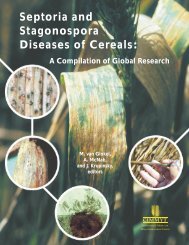Section 3 (Crop Management)
Section 3 (Crop Management)
Section 3 (Crop Management)
Create successful ePaper yourself
Turn your PDF publications into a flip-book with our unique Google optimized e-Paper software.
Tillage practices in corn<br />
Tillage x fertilizer trial<br />
On-farm trials conducted in Brgys. Mangarin and Mabini, San Jose, Mindoro Occidental tested zero<br />
tillage and conventional tillage against farmers’ tillage practice for yellow corn (var C 818) in<br />
combination with different fertilizers levels.<br />
In zero tillage, rice stubbles and newly grown weeds are evenly sprayed with POWER TM herbicide at<br />
the rate of 6 – 8 li ha -1 . Planting was done a day after herbicide application in the traditional method using<br />
a pointed wood called “bugsok” (Figure 1). If the soil is hard, the field is flooded two to three days before<br />
spraying herbicide. For farmers’ tillage, one to two plowing and one harrowing are made to prepare the<br />
land. Seeds are planted at a rate of one seed per hill (70 cm x 20 cm spacing) also using the “bugsok”<br />
method of planting. In conventional tillage, land is thoroughly prepared with two passes of tractor-drawn<br />
plow and two times harrowing using a hand tractor or animal-drawn harrow. Seeds are planted using<br />
“farmalite” (manual corn seed planter) at a rate of one seed per hill, with 70 x 20 cm spacing (Figure 2).<br />
The two fertilizer levels used in combination with the three tillage practices were: F1 - 600 kg ha -1<br />
ammosul and F2 - 300 kg ha -1 ammosul + 1 kg ha -1 BIO-N. First fertilizer application of ammosul was<br />
done 15-20 DAP at 300 kg ha -1 for F1 and 150 kg ha for F2. Second application was at 45 DAP using the<br />
same amount of ammosul.<br />
BIO-N is a microbial-based fertilizer for rice and corn. It is mainly composed of microorganisms that<br />
can convert the nitrogen from the air into ammonia, and replaces up to 75 percent of the total amount of<br />
nitrogen requirement of rice and corn.<br />
Tillage x variety trial<br />
The on-farm tillage x variety trial was done in the municipality of Barangay Sibao, Calabanga,<br />
Camarines Sur. Five farmer-partners were involved in the trial. Tillage management were tested in<br />
combination with different corn hybrid varieties. Conservation tillage, minimum tillage, and farmer’s<br />
tillage were the three-tillage practices tested. Varieties include IPB 929, Pioneer 3013 and Cargill 818<br />
applied with 300 kg ha –1 . Organic Fertilizer + 200 kg ha –1 Complete + 100 kg ha -1 Ammophos + 150 kg<br />
ha -1 Urea + 250 kg ha -1 lime.<br />
Similar to the other trials, with zero tillage six to eight liters POWER TM herbicide was applied<br />
followed by one light pass of furrow (slit) a day after herbicide application. A 70 cm x 20 cm planting<br />
distance at one seed per hill was also adopted. On the other hand, in the case of minimum tillage one<br />
plowing and harrowing was done followed by application of four liters per hectare of POWER TM<br />
herbicide10 to 14 days before planting. Likewise, furrowing was done one day after herbicide application<br />
to facilitate planting of corn seeds. A 70 cm x 20 cm planting distance (one seed per hill) was used. For<br />
farmer’s tillage land preparation starts with two plowing and two harrowing followed by furrowing,<br />
hilling up or cultivation and row weeding.<br />
Results and Discussion<br />
Mindoro Occidental<br />
The analysis of variance (ANOVA) for grain yield obtained by four farmer-partners in testing the<br />
performance of Cargill 818 under three tillage practices and two levels of fertilizer is presented in Table<br />
1. The table reveals that variation in grain yield was due to the tillage practices employed and not to the<br />
levels of fertilizer or the interaction between the two treatments.<br />
Mean grain yield under tillage practices (Table 2) show that the use of zero tillage produced the<br />
highest grain yield of about 5.20 t ha -1 followed by the conventional tillage with 5.17 t ha -1 . Farmer’s<br />
tillage practice on the other hand ranks last with only 4.08 t ha -1 .<br />
- 298 -









